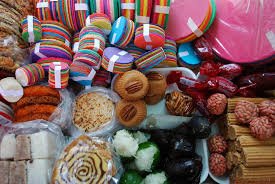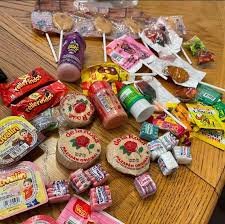Mexican candy is a vibrant tapestry of flavors, textures, and traditions that reflect the rich cultural heritage of Mexico. From the bustling markets of Oaxaca to the festive streets of Mexico City, these sweets offer a delightful fusion of indigenous ingredients and colonial influences. Whether you’re a seasoned connoisseur or a curious newcomer, exploring Mexican candy is an adventure for the senses.
Table of Contents
The Essence of Mexican Candy
At the heart of Mexican candy lies a harmonious blend of sweet, sour, salty, and spicy elements. This unique combination sets it apart from other confectioneries around the world. Key ingredients such as tamarind, chili, and piloncillo (unrefined sugar) are staples in many treats, offering bold and complex flavors that captivate the palate. The use of natural fruits like mango, pineapple, and guava further enhances the authenticity and diversity of Mexican candy.
A Brief History of Mexican Candy

The origins of Mexican candy trace back to pre-Hispanic times when indigenous peoples utilized native fruits, seeds, and natural sweeteners to create confections. The arrival of the Spanish introduced new ingredients like sugar and chocolate, leading to a fusion of culinary traditions. Over centuries, this blend evolved into the diverse array of Mexican candy we cherish today.
Popular Varieties of Mexican Candy
The world of Mexican candy is vast and varied, with each region offering its own specialties. Here are some beloved treats that showcase the diversity of flavors:
- Pulparindo: A tangy tamarind-based candy seasoned with chili powder and salt, offering a perfect balance of sweet and spicy.
- Mazapán: A crumbly peanut confection that melts in your mouth, often enjoyed as a nostalgic snack.
- Paleta Payaso: A marshmallow lollipop coated in chocolate and colorful sprinkles, combining sweetness with a playful presentation.
- Vero Mango: A dried mango center enveloped in a chili-salt coating, delivering a burst of tropical heat.
- Duvalin: A creamy pudding-like treat available in flavors like hazelnut and vanilla, perfect for dipping.
- Cocadas: Chewy coconut candies infused with cinnamon and sugar, offering a tropical delight.
- Borrachitos: Soft jelly candies soaked in syrup and a hint of liquor, originating from Puebla.
- Glorias: Goat’s milk and pecan candies wrapped in red cellophane, known for their rich and creamy texture.
- Palanquetas: Nut bars made from peanuts or sunflower seeds bound with caramelized sugar or piloncillo.
- Tamarind Trozos con Chile: Chunks of tamarind coated with chili powder, offering a tangy and spicy flavor profile.
The Role of Ingredients in Mexican Candy
The distinctive taste of Mexican candy is largely attributed to its unique ingredients:
- Tamarind: A sour fruit that adds a tangy depth to candies like Pulparindo and tamarind trozos.
- Chili: Various types of chili, such as Tajín and chili powder, are used to infuse heat and complexity into sweets.
- Piloncillo: Unrefined sugar that imparts a rich, molasses-like sweetness to confections.
- Cajeta: A caramel made from goat’s milk, commonly used in candies like Glorias and Obleas.
- Nuts: Peanuts, pecans, and pumpkin seeds are frequently incorporated into candies like Palanquetas and Cocadas.
- Fruits: Tropical fruits such as mango, guava, and pineapple are often featured in candies like Vero Mango and tamarind trozos.
Cultural Significance of Mexican Candy

Beyond their delightful flavors, Mexican candies hold cultural importance. They are integral to celebrations like Día de los Muertos, where sugar skulls (calaveras de azúcar) are crafted as offerings to honor deceased loved ones. These candies also play a role in everyday life, from street vendors selling treats in bustling markets to family gatherings where sweets are shared among loved ones.
Modern Trends in Mexican Candy
In recent years, Mexican candy has gained international popularity, leading to innovative adaptations:
- Chamoy Pickle Kits: A viral trend originating from San Antonio, these kits allow enthusiasts to create spicy, tangy pickles infused with chamoy and stuffed with candies. citeturn0news14
- Jarritos Candy Line: The beloved Mexican soda brand Jarritos has expanded into the candy market, offering gummies and lollipops in flavors like pineapple, mango, and tamarind. citeturn0news13
- Taco Truck Jelly Beans: A quirky creation by Brach’s, these jelly beans come in flavors inspired by Mexican cuisine, including churro, horchata, and salsa. citeturn0news15
Also read Barbers Near Me Your Ultimate Guide to Finding the Best Local Barbershops in Hyderabad, Sindh
Where to Find Mexican Candy
Whether you’re in Mexico or elsewhere, there are numerous places to explore the world of Mexican candy:
- Local Markets: Traditional markets in Mexico are teeming with stalls offering a vast array of candies.
- Specialty Stores: International grocery stores and specialty shops often carry a selection of Mexican candy.
- Online Retailers: Websites dedicated to Mexican sweets provide convenient access to a wide variety of confections.


